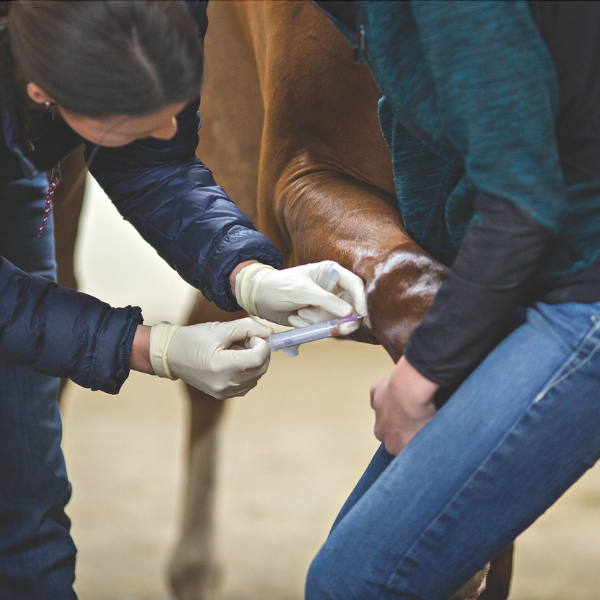For those who have been around horses for many years, we have seen major advances in equine medicine and treatments. Many of the diagnosis techniques, treatments and rehabilitation methods available to top human athletes are now available to equine athletes as well.
Long gone is the day of only having one choice to treat your horse for various injuries or illnesses. Now owners have a plethora of options and the ability to research various treatment modalities at their fingertips through web searches.
Diagnostic advances include digital X-rays, digital ultrasound, endoscopy, advances in blood tests, and TendiBoot Technology, just to name a few. Digital X-ray versus the traditional radiographs have the capability to produce clearer, instant results. The advancement of digital ultrasound allows veterinarians to see images in real time, thus allowing them to assess blood flow and soft tissue stable- side. This type of diagnostic device is useful in evaluating issues of the musculoskeletal, gastrointestinal, and reproductive systems. Endoscopy can be used in evaluating issues in the gastrointestinal system and upper respiratory tract, and TendiBoots are used to diagnose tendonitis, desmitis, neuropathy, and underperformance. TendiBoots allow for early detection of issues and monitoring of the rehabilitation progress made by the horse.
Treatment advances in equine medicine are numerous. Hyperbaric Oxygen Therapy (HBOT), Cold Saltwater Leg Spa, Aqua Treadmill, Vibration Plate, Hyaluronic Acid Injections, Platelet Rich Plasma (PRP), and mesotherapy are just to name a few. Hyperbaric Oxygen Therapy (HBOT) is a procedure that delivers an increased amount of oxygen to the horse being treated. The treatment consists of placing the horse in a special oxygen rich stall that has increased atmospheric pressure. This allows the horse to breathe in a higher concentration of oxygen. This type of therapy is beneficial for expediting the healing process for many types of injuries and illnesses. Typically the treatment is done at an equine veterinarian facility, however, there are some practices that have smaller portable chambers allowing them to be treated when transport of the horse is not an option according to Kentucky Equine Research’s website, www.KER.com
Another treatment option utilizes vibration plates, which are platforms that the horse stands on that provide gentle vibration. This vibration movement increases circulation and aids in building muscle tone, helps burn fat, reduces muscle stiffness, among other benefits.
Mesotherapy is another advancement in equine medicine used primarily in the treatment of neck and back issues in horses. A multi-needle injector is used to deliver medication to the mesoderm, which is the middle layer of the skin. Mesotherapy helps stop the pain cycle on a much deeper level, by inhibiting the nerve receptors responsible for feeling pain.
Joint issues can plague high performance equine athletes. Hyaluronic acid and corticosteroids injections are given in the joints to help stop problems before they occur and to treat horses with degenerative cartilage. According to American Association of Equine Practitioners’ article: Lameness and Joint Medications, written by Benjamin Espy, DVM, DACT and Justin Harper, DVM, MS, DACVS, LA, “Inflammatory and degradative enzymes that destroy normal joint environments can be altered by use of hyaluronic acid (HA) and corticosteroids injected into the joint. The combination of the two has been scientifically proven to have a more thorough and lasting effect than HA alone or corticosteroids alone.”
Some of these advances are used by equine veterinarians in the field as portable diagnostic and treatment modalities, allowing the equestrian and the horse to be treated at their own barn, which eliminates transport stress. Dr. Mark Akin, DVM of Collierville, Tennessee, provides portable, stall side services to his patients including diagnostics (such as digital ultrasound, digital X-ray, endoscopy, blood-work, and TendiBoot Technology), treatment, and rehabilitative medicine. According to Dr. Akins, the main focus of his practice is lameness and performance, so he carries numerous joint injection products, including but not limited to: steroids, hyaluronic acid, ProStride, PRP, Renovo (Amnion), Polyacrylamide Gel (Noletrex and Arthramid), and Alpha2Equine (Macroglobulin). These products also work for joint bursar, SI, and soft tissue injections.
As we enter a new era of medicine for both horse and rider, the options become more advanced and more readily available. The key to providing your horse with the best diagnostics and treatment options available is having an open communicative relationship with your equine veterinarian as you care for and advocate for your horse.









